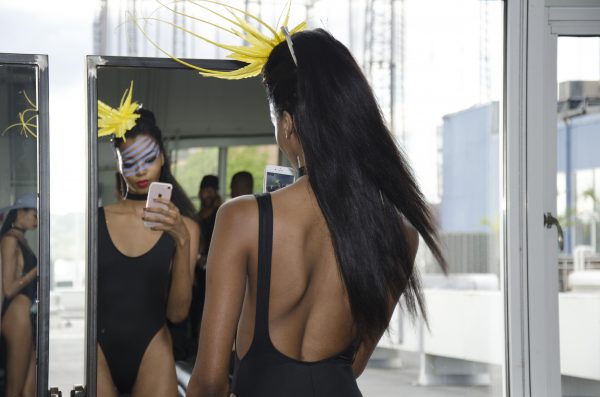Is Social Media Taking the Experience out of New York Fashion Week?
Models pose backstage and on display at the whimsical Eugenia Kim presentation at Pier 59 Studios on September 9, 2017 in NYC. (ANDRONIKA ZIMMERMAN/ THE OBSERVER)
September 27, 2017
The once glitzy and glamorous New York Fashion Week used to be the bi-annual hub of New York City with fashionistas, editors, and regular Jane Doe’s alike walking the streets with an extra pip in their step and accessory on their ensemble. This has all changed with the evolution of social media in conjunction with lazy millennials. Though masses of bodies used to wait on lines outside the Skylight at Clarkson Square to snag a seat inside the show, trend setters are now opting to livestream shows at home sans all the glitter and fuss that NYFW elicits.
This year between Sept. 7 and 13, 97 designers displayed their Spring/Summer 2018 collection— 36 percent of whom chose to live-stream their show.
The inception of live streaming fashion shows initially seemed like a great idea to reach the millennial demographic, and couture houses have been rapidly adjusting. Thirty-five designers instantaneously streamed their fashion shows on their website and social media channels this season. That’s a huge number considering this technology was only pioneered within the past 3-5 years. As predicted, viewers are tuning in. Unpredictably, they’re tuning in online en lieu of showing up in person. With budgets decreasing and fashion houses forced to reconstruct to maintain their audience, it seems as if fashion is dumping traditional high fashion and moving full speed ahead towards instant fashion in aims of public pleasing and selling as many clothes to as many people as possible.
Social media is immensely helping a brand’s popularity and many designers who stream their shows have adopted a “see-now-buy-now” aspect to go with their show that allows buyers to purchase the ready-to-wear collection seconds after it finishes. Not only does this deter viewers from participating in the fun of fashion week, but it can limit sales by deterring prospective buyers from making the trip to the store as well. Last February, Tommy Hilfiger debuted his Tommy x GiGi collaboration with model Gigi Hadid with a livestream, giving the public unprecedented access to NYFW trends. Fast fashion brand H&M launched their 2017 collection online on Wednesday Sept. 14 to the public online without even putting on a traditional show.
So what happens to the editorial publications and glossies that rely on print and online platforms to deliver the fashion to the public if their target audience has already seen the collection on others Snapchat stories? The concept of exclusivity crumbles.
If design houses choose to keep displaying their collections via live-stream, it’s possible Fashion Week could deconstruct completely. Focus is turning away from the press as a middle man and shifting towards how to entertain a public audience. When the coveted seats inside the show previously reserved for Vogue and Harper’s Bazaar editors become available to the world online for free, significant value is lost. If Louis Vuitton presents their collection in Paris Fashion Week, but live-streams it all over the world, does it matter whether it’s New York Fashion Week, Paris Fashion Week or Milan Fashion Week? The answer is simply no. Soon we may have a Universal Fashion Week, visible to all via public broadcasting and no one will have to leave their couch.
This concept strips NYFW of it’s authenticity . I personally live for the hustle and bustle of running from show to show and admiring the street style. All live streaming and see-now-buy-now collections have done for fashion is feed into our desire for instant gratification. While rules are meant to be broken in fashion, do we opt to stay traditional or conform and move full speed ahead into the future of digital streaming?
Featured image by Andronika Zimmerman/ The Observer











Kat • May 20, 2020 at 10:12 am
I don’t think so. This is the digital age so it just makes sense.